Palma de
Mallorca
From Nice we flew first to Barcelona, and
then onto Palma,
the capital of the island of Mallorca. I stayed there for four weeks
working
on courses toward my teacher's certification while Tracy joined me
for two weeks before flying home. While Palma has a reputation for
being
an endless stretch of resorts overrun with British and German tourists,
the old part of the city is a beautiful spot, reminiscent of Nice.
Below
are a few photos which attempt to capture that charm [click
on any image for a full screen version]
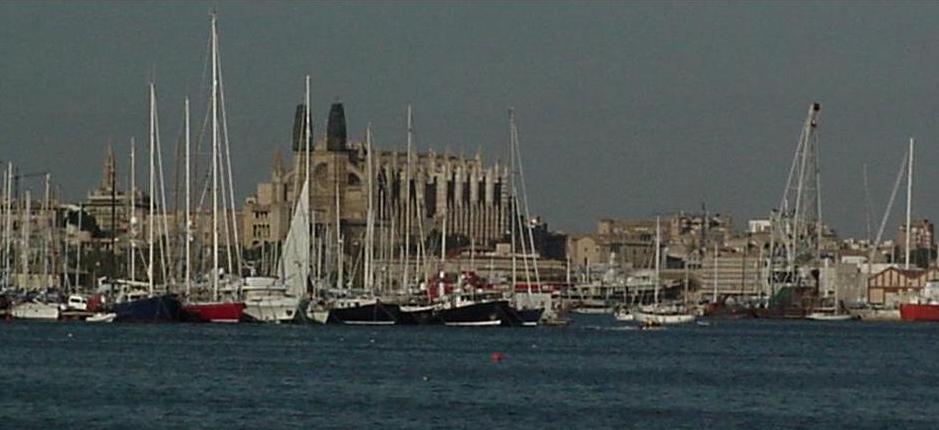 Our
tour begins with the harbor that forms the southern boundary of the
city.
It is a bustling place, full of cruise ships, sailboats, and
powerboats.
It also serves as a major port. There is a lovely corniche along its
entirety,
where I ran and Tracy walked daily. In the background you can see the
spires
of the Le Seo gothic cathedral.
Our
tour begins with the harbor that forms the southern boundary of the
city.
It is a bustling place, full of cruise ships, sailboats, and
powerboats.
It also serves as a major port. There is a lovely corniche along its
entirety,
where I ran and Tracy walked daily. In the background you can see the
spires
of the Le Seo gothic cathedral.
 Turning
your gaze inward from the Marina, Bellver Castle stands watch over
the harbor. In its heydey this prominently positioned fortress warned
of
pirates. Today it witnesses an endless profusion of cruise ships
filling
the west end of the harbor. Below is a 360 panoramic tour of the Castle.
Turning
your gaze inward from the Marina, Bellver Castle stands watch over
the harbor. In its heydey this prominently positioned fortress warned
of
pirates. Today it witnesses an endless profusion of cruise ships
filling
the west end of the harbor. Below is a 360 panoramic tour of the Castle.
Virtual Tour of
Bellver Castle
Instructions:
You may take the tour by clicking on the round navigation icons in each
scene, or by selecting the thumbnail option [ ]
from the menu at the bottom of the screen. You may view the tour in full-screen mode by clicking on the "full-screen" icon [
]
from the menu at the bottom of the screen. You may view the tour in full-screen mode by clicking on the "full-screen" icon [ ] on the menu at the bottom of the page. If you are using an older
computer and experiencing some "jumpiness" in the panorama, click on
the
compass icon [
] on the menu at the bottom of the page. If you are using an older
computer and experiencing some "jumpiness" in the panorama, click on
the
compass icon [ ]from the bottom menu to smooth things out.
]from the bottom menu to smooth things out.
 One
of my favorite spots as an avid sailor (something I finally got to do
here)
was the far end of the marina where the local sailors moor their boats.
Pictured here are the traditional Spanish sailboats, doubled-enders
with
wooden lapstrake hulls.
One
of my favorite spots as an avid sailor (something I finally got to do
here)
was the far end of the marina where the local sailors moor their boats.
Pictured here are the traditional Spanish sailboats, doubled-enders
with
wooden lapstrake hulls.
 This
fort is located on the waterfront across from the marina. Mallorca was
plagued through the 18th century by pirates plundering the mouth of the
Mediterranean Sea. Fortresses such as this dot the waterfront. It was
for
this reason that most of the major cities were located inland, using
Mallorca
as their supply depot.
This
fort is located on the waterfront across from the marina. Mallorca was
plagued through the 18th century by pirates plundering the mouth of the
Mediterranean Sea. Fortresses such as this dot the waterfront. It was
for
this reason that most of the major cities were located inland, using
Mallorca
as their supply depot.
 The
waterfront is lined with wonderful restaurants which feature both
seafood
of every imaginable type, and also tapas, the traditional Spanish dish
consisting of a variety of appetizers. Here Tracy and I take a breather
from our seafood platters at the Caballitos de Mer.
The
waterfront is lined with wonderful restaurants which feature both
seafood
of every imaginable type, and also tapas, the traditional Spanish dish
consisting of a variety of appetizers. Here Tracy and I take a breather
from our seafood platters at the Caballitos de Mer.
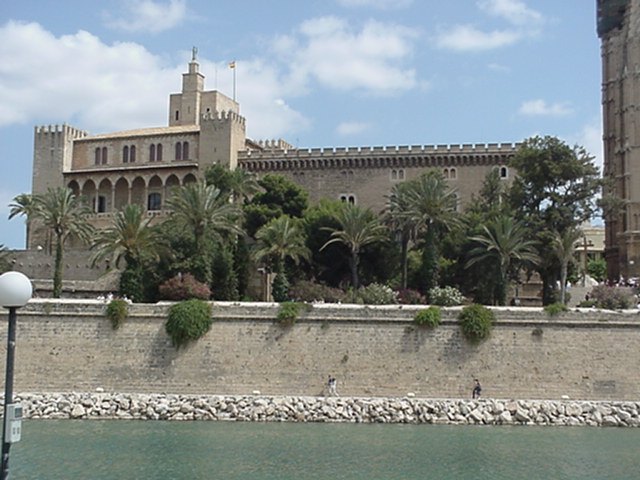
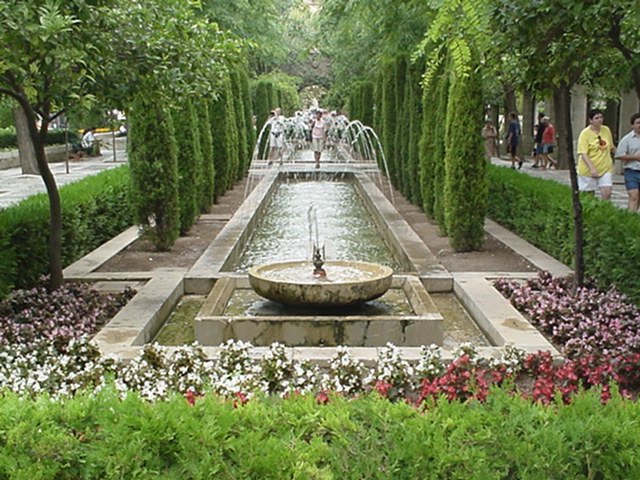 Just
down the street from the restaurant is the Palau de Almadaina, a
fortified
palace that is still used by the King on his summer trips to Mallorca.
The king also had a second, more modest palace next to Bellver college
where I studied--this palace is used primarily for ceremonies. The
photo
to the left shows the castle from the sea, while the picture at the
right
shows the garden entryway.
Just
down the street from the restaurant is the Palau de Almadaina, a
fortified
palace that is still used by the King on his summer trips to Mallorca.
The king also had a second, more modest palace next to Bellver college
where I studied--this palace is used primarily for ceremonies. The
photo
to the left shows the castle from the sea, while the picture at the
right
shows the garden entryway.
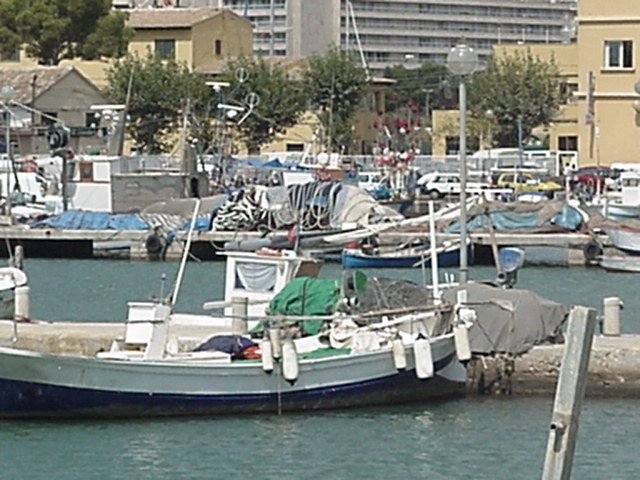
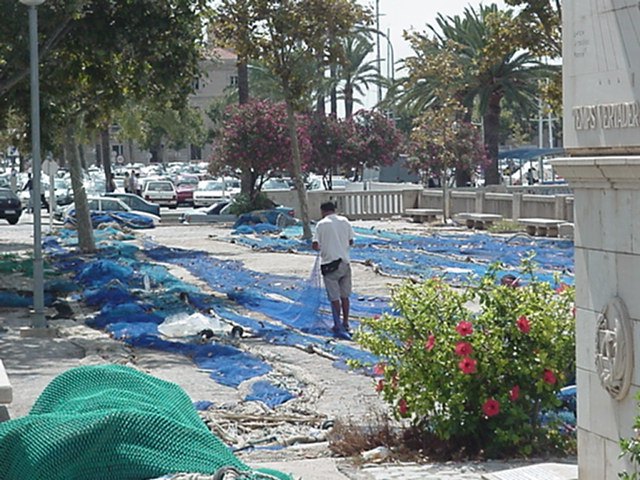 Continuing
along the harbor toward the east, we arrive at the fisherman's docks.
Palma
has a very active fishing fleet, providing hungry tourists like us with
the "fruits of the sea." On the left is a picture of the docks, while
the
photo at the right shows the daily ritual of fishermen mending the nets
when they return to port in the early afternoon--just in time for
siesta!
Continuing
along the harbor toward the east, we arrive at the fisherman's docks.
Palma
has a very active fishing fleet, providing hungry tourists like us with
the "fruits of the sea." On the left is a picture of the docks, while
the
photo at the right shows the daily ritual of fishermen mending the nets
when they return to port in the early afternoon--just in time for
siesta!

 Catedral-Basilica de Santa Maria
de Mallorca has been
described as a huge ship anchored at the end
of the harbor. As you can see from the first photograph on this page,
it
dominates the Palma skyline. Gothic
in its exterior (as shown from the facade at the left, and the side
profile
to your right) its interior was redesigned in modernista style
by
Antoni Gaudi at the beginning of the 20th century. The original
cathedral
was begun in 1230 and was completed in 1600. This is considered rapid
progress
by island standards!
Below is a tour featuring two panoramas, one of the cathedral in
the daytime and one at night.
Catedral-Basilica de Santa Maria
de Mallorca has been
described as a huge ship anchored at the end
of the harbor. As you can see from the first photograph on this page,
it
dominates the Palma skyline. Gothic
in its exterior (as shown from the facade at the left, and the side
profile
to your right) its interior was redesigned in modernista style
by
Antoni Gaudi at the beginning of the 20th century. The original
cathedral
was begun in 1230 and was completed in 1600. This is considered rapid
progress
by island standards!
Below is a tour featuring two panoramas, one of the cathedral in
the daytime and one at night.
Catedral-Basilica de Santa Maria de Mallorca
Instructions:
You may take the tour by clicking on the round navigation icons in each
scene, or by selecting the thumbnail option [ ]
from the menu at the bottom of the screen. You may view the tour in full-screen mode by clicking on the "full-screen" icon [
]
from the menu at the bottom of the screen. You may view the tour in full-screen mode by clicking on the "full-screen" icon [ ] on the menu at the bottom of the page. If you are using an older
computer and experiencing some "jumpiness" in the panorama, click on
the
compass icon [
] on the menu at the bottom of the page. If you are using an older
computer and experiencing some "jumpiness" in the panorama, click on
the
compass icon [ ]from the bottom menu to smooth things out.
]from the bottom menu to smooth things out.

Return to Travel Archives
 Our
tour begins with the harbor that forms the southern boundary of the
city.
It is a bustling place, full of cruise ships, sailboats, and
powerboats.
It also serves as a major port. There is a lovely corniche along its
entirety,
where I ran and Tracy walked daily. In the background you can see the
spires
of the Le Seo gothic cathedral.
Our
tour begins with the harbor that forms the southern boundary of the
city.
It is a bustling place, full of cruise ships, sailboats, and
powerboats.
It also serves as a major port. There is a lovely corniche along its
entirety,
where I ran and Tracy walked daily. In the background you can see the
spires
of the Le Seo gothic cathedral.

 ]
from the menu at the bottom of the screen. You may view the tour in full-screen mode by clicking on the "full-screen" icon [
]
from the menu at the bottom of the screen. You may view the tour in full-screen mode by clicking on the "full-screen" icon [ ] on the menu at the bottom of the page. If you are using an older
computer and experiencing some "jumpiness" in the panorama, click on
the
compass icon [
] on the menu at the bottom of the page. If you are using an older
computer and experiencing some "jumpiness" in the panorama, click on
the
compass icon [ ]from the bottom menu to smooth things out.
]from the bottom menu to smooth things out.








